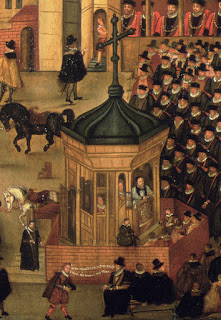Tiffany Stern, a Fellow of University College and Lecturer in English at Oxford University, read a paper entitled "'Observe the Sawcinesse of the Jackes': Clock Jacks and the Complexity of Time in Early modern England" today at the annual meeting of the Modern Language Association in Seattle, Washington.
Stern argued that time in the early modern period was a variable unit of measurement. For example, the hour glasses that marked the time of a sermon were hand made and varied in size from glass to glass, and also varied in the size of the grains of sand used to fill each one.
So even though the typical glass used for a church sermon was intended to mark the passage of one hour, the actual amount of time measured could vary from glass to glass, and thus from church to church.
The time measured by a given glass could also vary from time to time, since factors like changes in humidity could affect the rate at which the sand would flow through each glass.
Stern also reported that the churches in London rang bells on the hour, except for St Paul's, where the bells rang on the quarter hour as well as on the hour. St Paul's was known to have the most accurate clock in London, and other London churches rang bells on their own time.
This suggests that part of the ambient noise for a Paul's Cross sermon could have been the sounds of distant bells ringing on different schedules.
This also suggests that when Donne in one of his sermons at St Paul's says that people listening to sermons sometimes reacted to the preacher's points by interrupting him for up to a quarter of an hour, he had the sound of the cathedral bells ringing the quarter-hour to help him judge the length of the interruption.
I will be contacting Professor Stern to explore with her some more implications of her work for teh experience of the Paul's Cross Sermon. Stay tuned!








